Silphinae
Derek S. Sikes, Stephen T. Trumbo, and Stewart B. Peck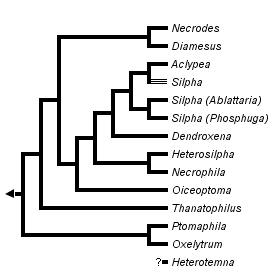


This tree diagram shows the relationships between several groups of organisms.
The root of the current tree connects the organisms featured in this tree to their containing group and the rest of the Tree of Life. The basal branching point in the tree represents the ancestor of the other groups in the tree. This ancestor diversified over time into several descendent subgroups, which are represented as internal nodes and terminal taxa to the right.

You can click on the root to travel down the Tree of Life all the way to the root of all Life, and you can click on the names of descendent subgroups to travel up the Tree of Life all the way to individual species.
For more information on ToL tree formatting, please see Interpreting the Tree or Classification. To learn more about phylogenetic trees, please visit our Phylogenetic Biology pages.
close boxBased on maximum likelihood tree from Dobler & Müller (2000) with unpublished data (Sikes) for placement of Diamesus and Oxelytrum. The genus Heterotemna was not sampled.
Introduction
Commonly referred to as the "Large carrion beetles," the subfamily Silphinae has approximately 113 species in 12 extant, validly recognized, genera since the most recent generic changes to the subfamily by Peck (2001).
These beetles are primarily necrophagous, and although they will feed on small carcasses (Bishop, 2001) they usually reproduce only on large carcasses (>300 g). The opposite pattern is seen in the sister subfamily, the Nicrophorinae.
There is a relatively extensive literature on silphid biology, although primarily focused on the more behaviorally complex species of the Nicrophorinae, much of which has been reviewed by Anderson and Peck (1985), Ratcliffe (1996), Eggert and Müller (1997) and Scott (1998). Heymons published a series of classic works describing the biology of various European silphine species (Heymons et al. 1926, 1927, 1928, 1929, 1930a, 1930b; Heymons & Lengerken 1931, 1932a, 1933b, 1934). The life history of Necrodes surniamensis was described by Ratcliffe (1972) but few other silphine species have been studied in detail. See Sikes (in press) for more detailed information on silphid biology, morphology, and phylogeny.
Characteristics
Silphines are dorso-ventrally flattened beetles and along with nicrophorines are among the largest-bodied of the staphylinoids, typically ranging in length from 12-20 mm. Their antennae are eleven segmented, and although the antennae of nicrophorines are eleven segmented also, nicrophorines have a greatly reduced pedicel (antennomere 2) that is fused to the scape (antennomere 1) making them appear to have a 10 segmented antenna. Silphines lack a frontoclypeal (epistomal) suture:

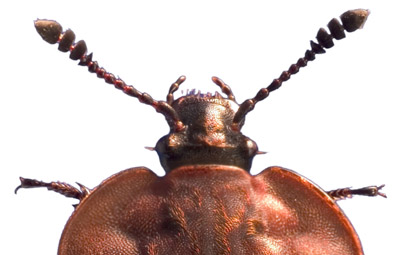
Head of Oiceoptoma subrufum showing the eleven segmented antennae and the absence of a frontoclypeal suture. Image copyright © 2005 Derek S. Sikes.
The larvae differ between the subfamilies as well with silphine larvae bearing a cluster of 6 stemmata (ocelli) on each side of the head and nicrophorine larvae bearing only a single stemma on each side.
Distribution
The genera, following the most recent classification of the subfamily by Peck (2001) are distributed as follows:
- HOLARCTIC:
- Aclypea (11 spp)
- Necrodes (3 spp.)
- Necrophila (18 spp.)
- Oiceoptoma (10 spp.)
- HOLARCTIC & AFRICA:
- Thanatophilus (24 spp.)
- EURASIA:
- Dendroxena (2 spp.)
- EURASIA & AFRICA:
- Silpha (26 spp.)
- WESTERN NEARCTIC:
- Heterosilpha (2 spp.)
- SOUTHWESTERN NEARCTIC & NEOTROPICAL:
- Oxelytrum (8 spp.)
- AUSTRALIA:
- Diamesus (2 spp.)
- Ptomaphila (3 spp.)
- AFRICA - CANARIES:
- Heterotemna (3 spp.)
Discussion of Phylogenetic Relationships
Dobler and Müller (2000) inferred the phylogenetic relationships of 9 genera of the Silphinae and 2 of the Nicrophorinae using sequences of the genes COI and COII. Their results were, however, contrary to the conclusions of all prior workers of this family (Hatch, Portevin, Crowson, Hansen, Madge, Newton, et al.) which placed the genera Necrodes and Diamesus basal within the Silphinae (or as a distinct tribe). Dobler and Müller's (2000) study placed Ptomaphila as the basal silphine with Necrodes fully two major branching events from the base of the subfamily. Their placement of Ptomaphila was well supported, and has remained so after the addition of another Ptomaphila species, a species of Oxelytrum (the sister genus of Ptomaphila) and the genus Diamesus, all of which were lacking in their original study (S. Dobler, in litt.; Sikes unpub. data).
If Necrodes + Diamesus are not the most basal Silphinae, and Ptomaphila + Oxelytrum are, then the evolution of various characters will need to be re-evaluated. For example, Necrodes + Diamesus have truncate elytra, and although of quite different forms, this state is shared in general with the Nicrophorinae:


Truncate elytra in Diamesus (Silphinae) on left and Nicrophorus (Nicrophorinae) on right. Image copyright © 2005 Derek S. Sikes.
Hatch (1927) considered these truncate elytra homologous.
However, given Dobler and Müller's conclusions this character is probably homoplastic: if Ptomaphila and Oxelytrum, which lack truncate elytra, are more closely related to the Nicrophorinae than Necrodes and Diamesus, the truncate elytra of Necrodes + Diamesus are likely to be convergent with the truncate elytra of the Nicrophorinae. For Dobler and Müller's tree to be correct and truncate elytra to be homologous across the basal split of the family would require one extra evolutionary event:

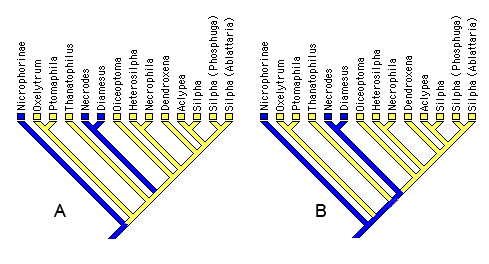
Alternate character evolution of truncate elytra in the Silphidae assuming the outgroup has truncate elytra. The most parsimonious mapping (A) requires two evolutionary changes: a change from truncate (blue) to nontruncate (yellow) at the base of the Silphinae and a reversal to truncate in the common ancestor of Necrodes + Diamesus. For the truncate elytra to be homologous (B) there would be three parallel evolutionary changes to nontruncate elytra in the Silphinae. Image copyright © 2005 Derek S. Sikes.
Classification
- SILPHINAE Latreille, 1807
- Silphales Latreille, 1807
- Necrodeidae Gistel, 1856
- Necrodini Portevin, 1926
- Aclypea Reitter, 1884
- Blitophaga Reitter, 1884
- Dendroxena Motschulsky, 1858
- Xylodrepa Thomson, 1859
- Diamesus Hope, 1840
- Heterosilpha Portevin, 1926
- Heterotemna Wollaston, 1864
- Necrodes Leach, 1815
- Cyclophorus Stephens, 1829
- Asbolus Bergroth, 1884
- Protonecrodes Portevin, 1922
- Necrophila Kirby and Spence, 1828
- subgenus Necrophila Kirby & Spence, 1828
- Necrobora Hope, 1840
- subgenus Eusilpha Semenov-Tian-Shanskij, 1890
- subgenus Calosilpha Portevin, 1920
- subgenus Deutosilpha Portevin, 1920
- subgenus Chrysosilpha Portevin, 1921
- Oiceoptoma Leach, 1815
- Oeceoptoma Agassiz, 1847
- Isosilpha Portevin, 1920
- Oxelytrum Gistel, 1848
- Hyponecrodes Kraatz, 1876
- Katanecrodes Schouteden, 1905
- Paranecrodes Portevin, 1921
- Ptomaphila Kirby & Spence, 1828
- Ptomatophila Agassiz, 1847
- Ptomacharis Portevin, 1932
- Silpha Linnaeus, 1758
- subgenus Silpha Linnaeus, 1758
- Parasilpha Reitter, 1884
- Carpatosilpha Smetana, 1951
- subgenus Phosphuga Leach, 1817
- Phosphyga Agassiz, 1847
- subgenus Ablattaria Reitter, 1884
- Thanatophilus Leach, 1815
- Pseudopelta Bergroth, 1884
- Philas Portevin, 1903
- Silphosoma Portevin, 1903
- Chalcosilpha Portevin, 1926
The 12 extant genera are as follows, after the most recent classification of the subfamily by Peck (2001), who focused on the Nearctic taxa, with modifications to accomodate Old World and Neotropical taxa based on Madge in litt. Subgenera and junior synonyms are indented below the valid genus name:
References
Anderson, R. S. & Peck, S. B. 1985. The Carrion Beetles of Canada and Alaska (Coleoptera: Silphidae and Agyrtidae). The Insects and Arachnids of Canada, Part 13. Publication 1778, Research Branch Agriculture Canada, Ottawa. 121 pp
Bishop, A. A. 2001. Niche segregation, carcass preparation, and the effects of land management on the ecology of carrion beetles (Coleoptera: Silphidae) in Kearney County, Nebraska. M.S. Thesis. University of Nebraska at Kearney, 115 pp.
Dobler, S. & Müller, J. K. 2000. Resolving phylogeny at the family level by Mitochondrial Cytochrome Oxidase sequences: Phylogeny of carrion beetles (Coleoptera: Silphidae). Molecular Phylogenetics and Evolution 15(3): 390-402
Eggert, A. -K. & J. K. Müller. 1997. Biparental care and social evolution in burying beetles: Lessons from the larder. pp. 216-236 in Social Behavior in Insects and Arachnids (J. C. Choe, B. J. Crespi, eds.) Cambridge University Press, Cambridge, New York & Oakleigh: v-xiii, 1-541.
Hatch, M. H. 1927. Studies on the Silphinae. Journal of the New York Entomological Society 35: 331-370.
Heymons, R., H. von Lengerken, & M. Bayer. 1926. Studien über die Lebenserscheinungen der Silphini (Coleopt.). I. Silpha obscura L. Zeitschrift für Morphologie und Ökologie der Tiere 6: 287-332.
Heymons, R., H. von Lengerken, & M. Bayer. 1927. Studien über die Lebenserscheinungen der Silphini (Coleopt.). II. Phosphuga atrata L. Zeitschrift für Morphologie und Ökologie der Tiere 9: 271-312.
Heymons, R., H. von Lengerken, & M. Bayer. 1928. Studien über die Lebenserscheinungen der Silphini (Coleopt.). III. Xylodrepa quadripunctata L. Zeitschrift für Morphologie und Ökologie der Tiere 10: 330-352.
Heymons, R., H. von Lengerken, & M. Bayer. 1929. Studien über die Lebenserscheinungen der Silphini (Coleopt). IV. Blitophaga opaca L. (Glattstreifiger Rübenaaskäfer). Zeitschrift für Morphologie und Ökologie der Tiere 14: 234-260.
Heymons, R., H. von Lengerken, & M. Bayer. 1930a. Studien über die Lebenserscheinungen der Silphini (Coleopt.). V. Silpha tyrolensis Laich. Zeitschrift für Morphologie und Ökologie der Tiere 17: 262-274.
Heymons, R., H. von Lengerken, & M. Bayer. 1930b. Studien über die Lebenserscheinungen der Silphini (Coleopt). VI. Blitophaga undata Müll. (Buckelstreifiger Rübenaaskäfer). Zeitschrift für Morphologie und Ökologie der Tiere 18: 170-188.
Heymons, R., & H. von Lengerken. 1931. Studien über die Lebenserscheinungen der Silphini (Coleopt). VII. Oiceoptoma thoracica L. Zeitschrift für Morphologie und Ökologie der Tiere 20: 691-706.
Heymons, R., & H. von Lengerken. 1932a. Studien über die Lebenserscheinungen der Silphini (Coleopt). VIII. Ablattaria laevigata F. Zeitschrift für Morphologie und Ökologie der Tiere 24: 259-287.
Heymons, R., & H. von Lengerken. 1932b. Studien über die Lebenserscheinungen der Silphini (Coleopt). IX. Silpha carinata L. Zeitschrift für Morphologie und Ökologie der Tiere 25: 534-548.
Heymons, R., & H. von Lengerken. 1934. Studien über die Lebenserscheinungen der Silphini (Coleopt). X. Silpha tristis Illig. Zeitschrift für Morphologie und Ökologie der Tiere 28: 469-479.
Ratcliffe, B. C. 1972. The natural history of Necrodes surinamensis (Fabr.) (Coleoptera: Silphidae). Transactions of the American Entomological Society 98: 359-410.
Peck, S. B. 2001. Silphidae. pp. 268-271. in: R. H. Arnett and M. C. Thomas (eds). American Beetles: Archostemata, Myxophaga, Adephaga, Polyphaga: Staphyliniformia. Vol.1 Boca Raton: CRC Press. 443 pp.
Scott, M. P. 1998. The ecology and behavior of burying beetles. Annual Review of Entomology 43:595-618.
Sikes, D. S. in press. Silphidae. in: Handbook of Zoology, Hexapoda (Kristensen, N. P. & Beutel, R. G. eds.), Coleoptera I (Beutel, R. G. & Leschen, R. A. B. eds.). De Gruyter, Berlin.
Title Illustrations

Diamesus osculans (Vigors, 1825): a silphine with superficial adult similarities to the Nicrophorinae.
| Scientific Name | Diamesus osculans (Vigors, 1825) |
|---|---|
| Location | AUSTRALIA: Queensland: Cairns |
| Comments | Diamesus osculans (Vigors, 1825): a silphine with superficial adult similarities to the Nicrophorinae. |
| Identified By | D. S. Sikes |
| Sex | Male |
| Life Cycle Stage | adult |
| View | dorsal |
| Collector | D. S. Sikes |
| Image Use |
 This media file is licensed under the Creative Commons Attribution-NonCommercial-ShareAlike License - Version 3.0. This media file is licensed under the Creative Commons Attribution-NonCommercial-ShareAlike License - Version 3.0.
|
| Copyright |
© 2004 Derek S. Sikes

|
| Scientific Name | Diamesus osculans (Vigors, 1825) |
|---|---|
| Location | AUSTRALIA: Queensland: Cairns |
| Comments | Diamesus osculans (Vigors, 1825): a silphine with superficial adult similarities to the Nicrophorinae. |
| Identified By | D. S. Sikes |
| Life Cycle Stage | larva |
| View | dorsal |
| Collector | D. S. Sikes |
| Image Use |
 This media file is licensed under the Creative Commons Attribution-NonCommercial-ShareAlike License - Version 3.0. This media file is licensed under the Creative Commons Attribution-NonCommercial-ShareAlike License - Version 3.0.
|
| Copyright |
© 2004 Derek S. Sikes

|
About This Page
The following people contributed to the work on which we have based this web presentation. We thank them all for their advice, corrections, contributions of information, and support. Any errors remaining are our own. Michael Ivie, Ronald Madge, Piotr Naskrecki, Alfred Newton, Jan Ruzicka, Carl Schaefer, Chris Simon, Seizi Suzuki, and David Wagner. Many others, too numerous to list here, helped with specimen collection and museum loans, among other aspects of this research. We thank Katja Schulz for her considerable help with the editing and constructing this node of the Tree of Life. This work was funded in part by Grant DEB-9981381 from the National Science Foundation to Stephen Trumbo and Stewart Peck.
Derek S. Sikes

University of Calgary, Canada
Stephen T. Trumbo

University of Connecticut, Waterbury, Connecticut, USA
Stewart B. Peck

Carleton University, Ottawa, Ontario, Canada
Correspondence regarding this page should be directed to Derek S. Sikes at , Stephen T. Trumbo at , and Stewart B. Peck at
Page copyright © 2005 Derek S. Sikes, , and
 Page: Tree of Life
Silphinae.
Authored by
Derek S. Sikes, Stephen T. Trumbo, and Stewart B. Peck.
The TEXT of this page is licensed under the
Creative Commons Attribution-NonCommercial-ShareAlike License - Version 3.0. Note that images and other media
featured on this page are each governed by their own license, and they may or may not be available
for reuse. Click on an image or a media link to access the media data window, which provides the
relevant licensing information. For the general terms and conditions of ToL material reuse and
redistribution, please see the Tree of Life Copyright
Policies.
Page: Tree of Life
Silphinae.
Authored by
Derek S. Sikes, Stephen T. Trumbo, and Stewart B. Peck.
The TEXT of this page is licensed under the
Creative Commons Attribution-NonCommercial-ShareAlike License - Version 3.0. Note that images and other media
featured on this page are each governed by their own license, and they may or may not be available
for reuse. Click on an image or a media link to access the media data window, which provides the
relevant licensing information. For the general terms and conditions of ToL material reuse and
redistribution, please see the Tree of Life Copyright
Policies.
- First online 07 February 2005
Citing this page:
Sikes, Derek S., Stephen T. Trumbo, and Stewart B. Peck. 2005. Silphinae. Version 07 February 2005 (under construction). http://tolweb.org/Silphinae/26994/2005.02.07 in The Tree of Life Web Project, http://tolweb.org/




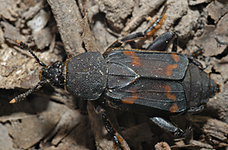
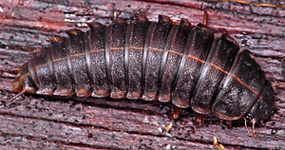
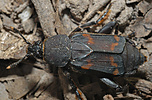
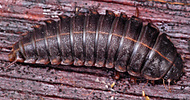

 Go to quick links
Go to quick search
Go to navigation for this section of the ToL site
Go to detailed links for the ToL site
Go to quick links
Go to quick search
Go to navigation for this section of the ToL site
Go to detailed links for the ToL site